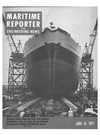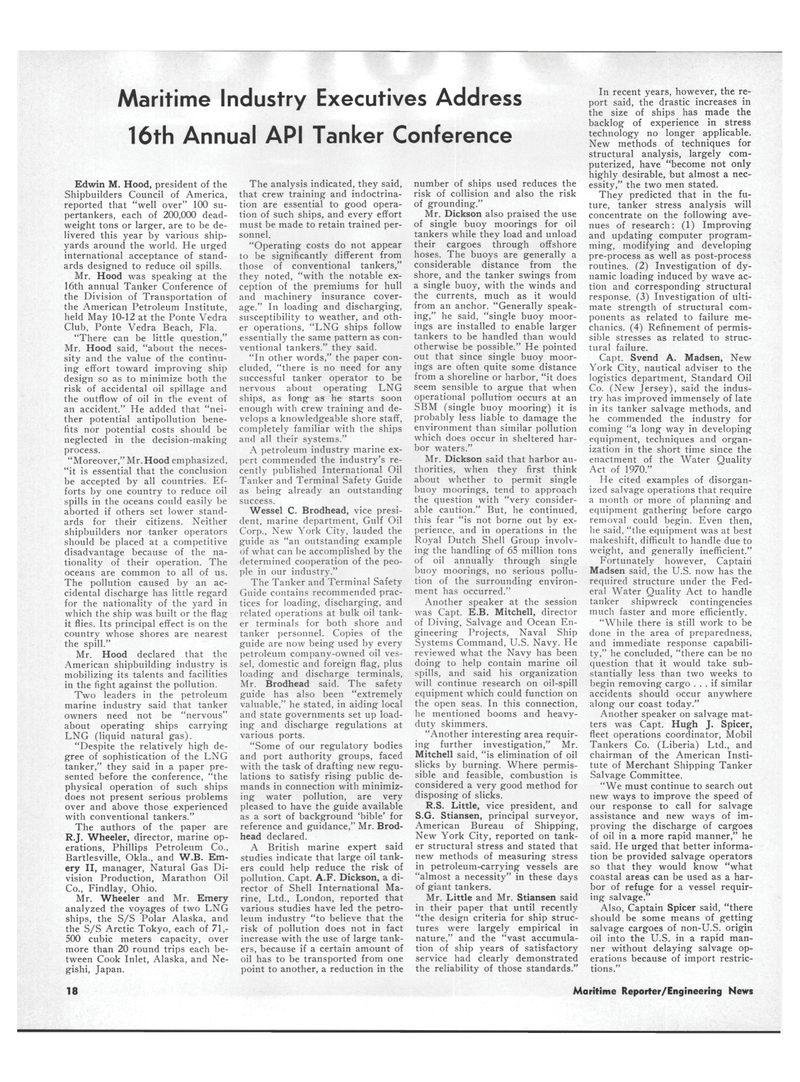
Page 16: of Maritime Reporter Magazine (June 15, 1971)
Read this page in Pdf, Flash or Html5 edition of June 15, 1971 Maritime Reporter Magazine
Maritime Industry Executives Address 16th Annual API Tanker Conference
Edwin M. Hood, president of the
Shipbuilders Council of America, reported that "well over" 100 su- pertankers, each of 200,000 dead- weight tons or larger, are to be de- livered this year by various ship- yards around the world. He urged international acceptance of stand- ards designed to reduce oil spills.
Mr. Hood was speaking at the 16th annual Tanker Conference of the Division of Transportation of the American Petroleum Institute, held May 10-12 at the Ponte Vedra
Club, Ponte Vedra Beach, Fla. "There can be little question,"
Mr. Hood said, "about the neces- sity and the value of the continu- ing effort toward improving ship design so as to minimize both the risk of accidental oil spillage and the outflow of oil in the event of an accident." He added that "nei- ther potential antipollution bene- fits nor potential costs should be neglected in the decision-making process. "Moreover," Mr. Hood emphasized, "it is essential that the conclusion be accepted by all countries. Ef- forts by one country to reduce oil spills in the oceans could easily be aborted if others set lower stand- ards for their citizens. Neither shipbuilders nor tanker operators should be placed at a competitive disadvantage because of the na- tionality of their operation. The oceans are common to all of us.
The pollution caused by an ac- cidental discharge has little regard for the nationality of the yard in which the ship was built or the flag it flies. Its principal effect is on the country whose shores are nearest the spill."
Mr. Hood declared that the
American shipbuilding industry is mobilizing its talents and facilities in the fight against the pollution.
Two leaders in the petroleum marine industry said that tanker owners need not be "nervous" about operating ships carrying
LNG (liquid natural gas). "Despite the relatively high de- gree of sophistication of the LNG tanker," they said in a paper pre- sented before the conference, "the physical operation of such ships does not present serious problems over and above those experienced with conventional tankers."
The authors of the paper are
R.J. Wheeler, director, marine op- erations, Phillips Petroleum Co.,
Bartlesville, Okla., and W.B. Em- ery II, manager, Natural Gas Di- vision Production, Marathon Oil
Co., Findlay, Ohio.
Mr. Wheeler and Mr. Emery analyzed the voyages of two LNG ships, the S/S Polar Alaska, and the S/S Arctic Tokyo, each of 71,- 500 cubic meters capacity, over more than 20 round trips each be- tween Cook Inlet, Alaska, and Ne- gishi, Japan.
The analysis indicated, they said, that crew training and indoctrina- tion are essential to good opera- tion of such ships, and every effort must be made to retain trained per- sonnel. "Operating costs do not appear to be significantly different from those of conventional tankers," they noted, "with the notable ex- ception of the premiums for hull and machinery insurance cover- age." In loading and discharging, susceptibility to weather, and oth- er operations, "LNG ships follow essentially the same pattern as con- ventional tankers." they said. "In other words," the paper con- cluded, "there is no need for any successful tanker operator to be nervous about operating LNG ships, as long as he starts soon enough with crew training and de- velops a knowledgeable shore staff, completely familiar with the ships and all their systems."
A petroleum industry marine ex- pert commended the industry's re- cently published International Oil
Tanker and Terminal Safety Guide as being already an outstanding success.
Wessel C. Brodhead, vice presi- dent, marine department, Gulf Oil
Corp., New York City, lauded the guide as "an outstanding example of what can be accomplished by the determined cooperation of the peo- ple in our industry."
The Tanker and Terminal Safety
Guide contains recommended prac- tices for loading, discharging, and related operations at bulk oil tank- er terminals for both shore and tanker personnel. Copies of the guide are now being used by every petroleum company-owned oil ves- sel, domestic and foreign flag, plus loading and discharge terminals,
Mr. Brodhead said. The safety guide has also been "extremely valuable," he stated, in aiding local and state governments set up load- ing and discharge regulations at various ports. "Some of our regulatory bodies and port authority groups, faced with the task of drafting new regu- lations to satisfy rising public de- mands in connection with minimiz- ing water pollution, are very pleased to have the guide available as a sort of background 'bible' for reference and guidance," Mr. Brod- head declared.
A British marine expert said studies indicate that large oil tank- ers could help reduce the risk of pollution. Capt. A.F. Dickson, a di- rector of Shell International Ma- rine, Ltd., London, reported that various studies have led the petro- leum industry "to believe that the risk of pollution does not in fact increase with the use of large tank- ers, because if a certain amount of oil has to be transported from one point to another, a reduction in the number of ships used reduces the risk of collision and also the risk of grounding."
Mr. Dickson also praised the use of single buoy moorings for oil tankers while they load and unload their cargoes through offshore hoses. The buoys are generally a considerable distance from the shore, and the tanker swings from a single buoy, with the winds and the currents, much as it would from an anchor. "Generally speak- ing," he said, "single buoy moor- ings are installed to enable larger tankers to be handled than would otherwise be possible." He pointed out that since single buoy moor- ings are often quite some distance from a shoreline or harbor, "it does seem sensible to argue that when operational pollution occurs at an
SBM (single buoy mooring) it is probably less liable to damage the environment than similar pollution which does occur in sheltered har- bor waters."
Mr. Dickson said that harbor au- thorities, when they first think about whether to permit single buoy moorings, tend to approach the question with "very consider- able caution." But, he continued, this fear "is not borne out by ex- perience, and in operations in the
Royal Dutch Shell Group involv- ing the handling of 65 million tons of oil annually through single buoy moorings, no serious pollu- tion of the surrounding environ- ment has occurred."
Another speaker at the session was Capt. E.B. Mitchell, director of Diving, Salvage and Ocean En- gineering Projects, Naval Ship
Systems Command, U.S. Navy. He reviewed what the Navy has been doing to help contain marine oil spills, and said his organization will continue research on oil-spill equipment which could function on the open seas. In this connection, he mentioned booms and heavy- duty skimmers. "Another interesting area requir- ing further investigation," Mr.
Mitchell said, "is elimination of oil slicks by burning. Where permis- sible and feasible, combustion is considered a very good method for disposing of slicks.
R.S. Little, vice president, and
S.G. Stiansen, principal surveyor,
American Bureau of Shipping,
New York City, reported on tank- er structural stress and stated that new methods of measuring stress in petroleum-carrying vessels are "almost a necessity" in these days of giant tankers.
Mr. Little and Mr. Stiansen said in their paper that until recently "the design criteria for ship struc- tures were largely empirical in nature," and the "vast accumula- tion of ship years of satisfactory service had clearly demonstrated the reliability of those standards."
In recent years, however, the re- port said, the drastic increases in the size of ships has made the backlog of experience in stress technology no longer applicable.
New methods of techniques for structural analysis, largely com- puterized, have "become not only highly desirable, but almost a nec- essity," the two men stated.
They predicted that in the fu- ture, tanker stress analysis will concentrate on the following ave- nues of research: (1) Improving and updating computer program- ming, modifying and developing pre-process as well as post-process routines. (2) Investigation of dy- namic loading induced by wave ac- tion and corresponding structural response. (3) Investigation of ulti- mate strength of structural com- ponents as related to failure me- chanics. (4) Refinement of permis- sible stresses as related to struc- tural failure.
Capt. Svend A. Madsen, New
York City, nautical adviser to the logistics department, Standard Oil
Co. (New Jersey), said the indus- try has improved immensely of late in its tanker salvage methods, and he commended the industry for coming "a long way in developing equipment, techniques and organ- ization in the short time since the enactment of the Water Quality
Act of 1970."
He cited examples of disorgan- ized salvage operations that require a month or more of planning and equipment gathering before cargo removal could begin. Even then, he said, "the equipment was at best makeshift, difficult to handle due to weight, and generally inefficient."
Fortunately however, Captain
Madsen said, the U.S. now has the required structure under the Fed- eral Water Quality Act to handle tanker shipwreck contingencies much faster and more efficiently. "While there is still work to be done in the area of preparedness, and immediate response capabili- ty," he concluded, "there can be no question that it would take sub- stantially less than two weeks to begin removing cargo ... if similar accidents should occur anywhere along our coast today."
Another speaker on salvage mat- ters was Capt. Hugh J. Spicer, fleet operations coordinator, Mobil
Tankers Co. (Liberia) Ltd., and chairman of the American Insti- tute of Merchant Shipping Tanker
Salvage Committee. "We must continue to search out new ways to improve the speed of our response to call for salvage assistance and new ways of im- proving the discharge of cargoes of oil in a more rapid manner," he said. He urged that better informa- tion be provided salvage operators so that they would know "what coastal areas can be used as a har- bor of refuge for a vessel requir- ing salvage."
Also, Captain Spicer said, "there should be some means of getting salvage cargoes of non-U.S. origin oil into the U.S. in a rapid man- ner without delaying salvage op- erations because of import restric- tions." 18 Maritime Reporter/Engineering News

 15
15

 17
17
